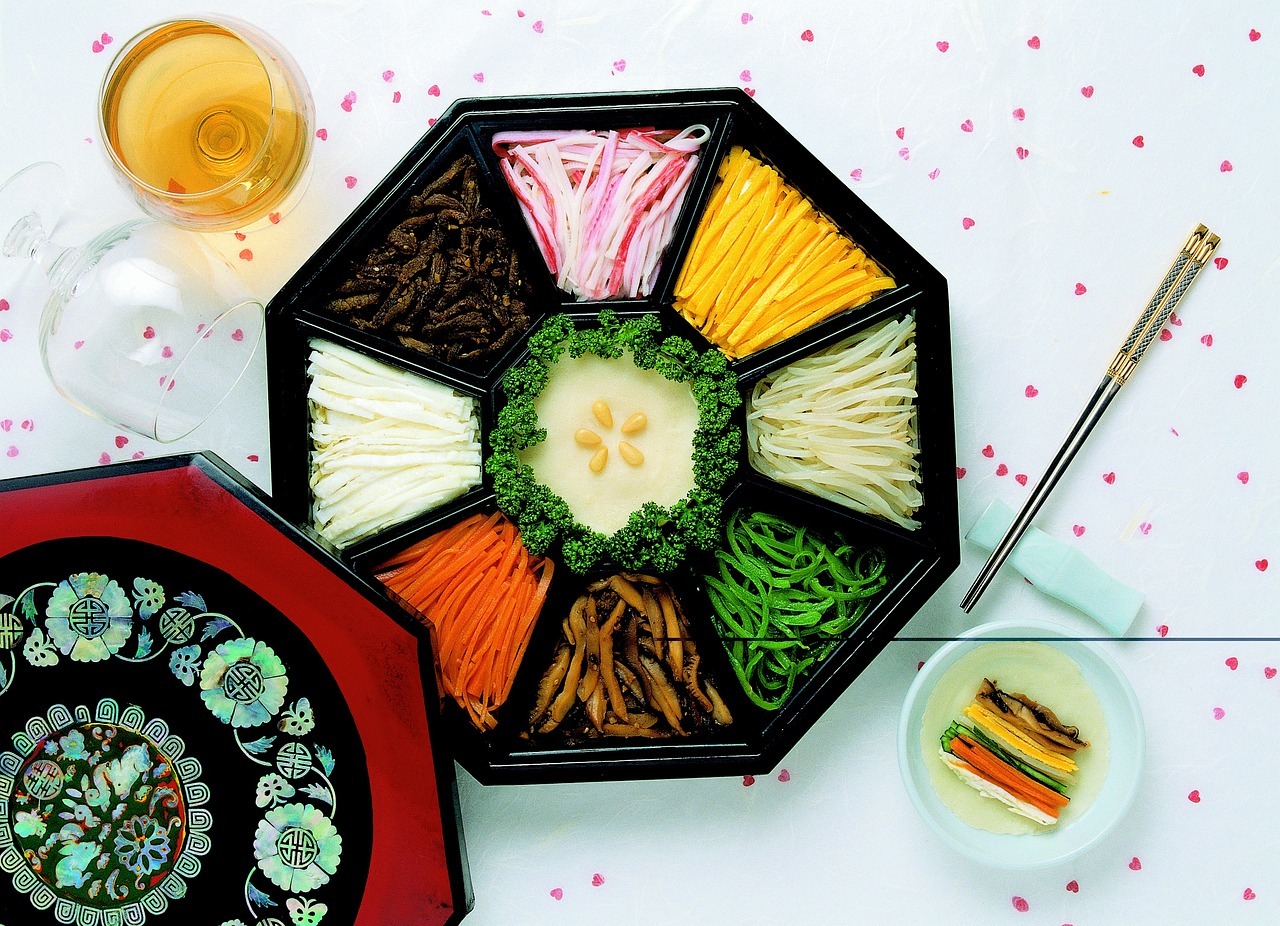Traditional Korean cooking has evolved over thousands of years, and incorporates the underlying belief that food is more than just a meal or basic sustenance, that food is medicine and when chosen and prepared correctly can prevent and even heal many illnesses.
Eumyangohaeng is another basic concept that heavily influences traditional foods. The belief that there is a balance between the five elements and Yin/Yang that must be achieved and maintained. For this reason a proper Korean table will include dishes or garnishes of five colors, (green, red, yellow, white, and black) which represent the five elements.
Cooking Korean food can appear daunting if you have not done it before. A lot of people look at the long ingredient lists and the long method descriptions and think that Korean cooking is hard to do, but it really isn’t.
A great many Korean recipes are actually constructed dishes which use a compilation of several different, usually basic, recipes. Most Korean restaurants will create these basic, or building block, recipes in large quantities that they keep on hand and can use as needed. Korean home cooks do the same thing, although on a smaller scale.
These building blocks are used as multi task ingredients which can, with the addition of a few more ingredients, be used in different combinations and quantities to create various “final” dishes which are far different from each other.
These “basic” ingredients include soup stocks (seafood, chicken, beef, pork, and vegetable stocks), various types of kimchi and other pickled vegetables, seasoning pastes (red pepper paste, soybean paste), seasoning sauces, marinades, etc.
However, most Korean dishes are really simple with some advance preparation like making the “building blocks” ahead of time and then refrigerating or freezing them for when needed. Only dishes (or components of dishes) requiring fresh delicate/highly perishable ingredients like fresh leaves or sprouts need be prepared on the day of the meal.
Most, if not all, soup stocks can made days, weeks, or even months before they are to be used. Since stocks are multi-use they can be used for non Korean dishes as well.
Meats used in making the different types of stock can be sliced, minced, shredded, seasoned, and frozen.
Kimchi and pickled vegetables keep well in the refrigerator for several weeks.
Many of the ban chan (small dishes served at Korean meals) dishes can be prepared a day or three before, and kept refrigerated.
Many of the basic preparations are now available commercially in Korean and other Asian markets, and can be used with quite good results.
Common Components of Korean Meals:
RICE:
Rice is served with almost every meal. The typical rice is a short or medium grain polished white rice, sometimes with legumes or grains added. On a few rare occasions, some type of noodle may replace the rice.
SOUPS:
Most Korean meals include either a small individual serving of soup, or a large shared stew.
BAN CHAN:
Every Korean meal includes a number of small shared side dishes known collectively as Ban Chan. These dishes range in number from 2 to 14 depending on how elaborate the meal is, and can include fresh or pickled vegetables, meats, or seafood.
SPICES:
The most common spices and sauces used in Korean cuisine are: sesame oil, chili pepper paste (kochujang), both fresh whole and ground dried chili peppers (gochu/gochukaru), soybean paste (doenjang), soy sauce, garlic, ginger, and scallions/green onions.
Getting Started:
First, determine whether you are going for a full Korean meal or just featuring a single dish, then look at the recipe(s) involved.
Check the ingredient lists against your pantry supplies and note what items you need to go shopping for. Some of the ingredients are available at larger mainstream markets, and some are likely only available at Korean/multi-Asian markets.
Shopping:
In general red meats for grilled dishes should be fairly lean, but well marbled. The marbleing (streaks or lines of white in the meat) adds flavor.
Meats for braises or dual purpose meats (stock first, then dish) should have a fair amount of external fat (fat cap or rim) in addition to the marbling. In braises the fat will render into the braisng liquid while for stocks the fat can be trimmed off the meat and added to the stock for more flavor.
Bones for soups or stocks should have some meat remaining to add more flavor to the stock.
Bone in, skin on poultry is more flavorful than boneless skinless cuts, but either can be used with good results. Whole poultry is better for soup stocks.
Vegetables should be fresh and unblemished, with few to no broken or crushed stems, leaves, etc. Avoid vegetables that have gone limp, have many blemishes/bruises, or have many yellowed, dried, or brittle portions.
Korean soy sauce comes in two main types, dark and light. “Light” or soup soy sauce is usually lighter colored, but more heavily salted than the dark and should not be substituted for the dark variety. The “dark” soy sauce is mostly used as a flavoring agent or in sauces and marinades.
The popular Kikkoman brand soy sauce is a “dark” soy sauce, but is usually saltier than the Korean variety. To avoid overly salty dishes, you can cut this soy sauce with sugar and honey (1 cup soy sauce, 1/3 cup sugar, 1/4 cup honey).
Soy bean paste, or doenjang, is used in many dishes. Korean soy bean paste is similar to Japanese miso but is much more pungent and powerful. Substituting miso for doenjang can yield some unpredictable results.
